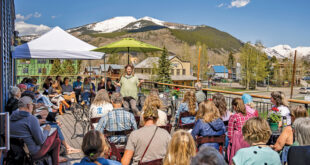Tour of energy-efficient greenhouse also offered
by Olivia Lueckemeyer
The sustainable living concept is widely embraced by the Crested Butte community, and this year the Crested Butte Film Festival will highlight this commitment through its screening of the Josh Fox documentary, How to Let Go of the World and Love All the Things Climate Can’t Change.
In conjunction with the film, local sustainable builder Kara Holzmiller of SmithWorks Natural Homes and Build. Sow. Grow. has organized an event to highlight sustainable businesses throughout the Gunnison Valley.
The film, which is sponsored by SmithWorks Natural Homes and Paradox Footwear, investigates climate change and the possibility that it may be too late to prevent some of the worst consequences. While the premise sounds dismal, the film ends on an inspiring note by highlighting the many things that climate cannot destroy.
“SmithWorks is very passionate about bringing awareness to the public about climate change and that’s the whole reason why we are trying to build in a more sustainable way,” Holzmiller explained. “The building sector accounts for almost 50 percent of the carbon dioxide emissions in the U.S., so we thought it would be great to feature some businesses that are involved in sustainability and climate change awareness and having a positive effect on the situation.”
Holzmiller reached out to organizations throughout the valley to set up booths before and after the documentary screens on three separate dates during the film festival to inform the public about sustainable practices. Tassinong Farms, SmithWorks Natural Homes, Nunatak Alternative Energy Solutions, The Mountain Roots Food Project and others have agreed to join the event, which begins Thursday, September 15 when the documentary is shown for the first time at 7 p.m. at the Crested Butte Center for the Arts.
As part of the event, Holzmiller will also offer tours on October 1 and October 2 of an energy-efficient greenhouse she recently built with her friend and former builder, Dustin Kujawski. Located on Kujawski’s property at 373 Cascadilla St. in Crested Butte South, the greenhouse is the first of its kind for this climate.
“Build. Sow. Grow. has just built its first prototype greenhouse, which is on the forefront of sustainable building by using passive solar design techniques, clay/straw walls, and climate battery to create the healthiest and most energy efficient greenhouse possible for this climate,” Holzmiller explained. “So far it’s one of a kind.”
Holzmiller and Kujawski began construction on the greenhouse at the end of May and are currently installing finishing touches to ready the structure for the upcoming open house.
“I had never really dealt with sustainable building in my previous construction experience, so I was really interested in that side of the process,” Kujawski explained.
The goal of Build. Sow. Grow., according to Holzmiller, is to utilize innovative techniques to create highly efficient greenhouses that require no supplemental heating and are built with non-toxic materials.
“It shouldn’t cost a lot of money to operate your greenhouse,” she explained. “The clay/straw walls will absorb solar radiation that directly hits the wall in the wintertime when the sun is lower in the sky.”
The greenhouse also employs a subterranean air-circulation system known as climate battery—a method pioneered by Jerome Oentowski of the Rocky Mountain Permaculture Institute in Basalt, Colo.—which takes the hot, moist, ambient air from the structure during the day, stores it in the soil, and discharges it at night to keep the greenhouses warm throughout the winter.
According to Kujawski, the hope is to extend the otherwise minimal grow season by about four to five months, and to be able to continue growing lettuces and herbs throughout the winter. So far the greenhouse is operating efficiently.
“Everything is doing really well,” he said. “We have a ton of flowers, tomatoes, peppers, lettuce and herbs. It got down to 33 degrees the other night and it was over 50 degrees in the greenhouse.”
Holzmiller describes the greenhouses as an “oasis,” or an escape from the cold, long winters characteristic of the Gunnison Valley.
“It’s a space where you can escape the never-ending winter, warm up and be surrounded by your plants and read a book or do some yoga,” she explained. “We all know how long the winters can get up here, so the idea was to provide some escape.”
The structure will double as a secondary office for Kujawski, who envisions himself spending time in the greenhouse when he’s not skiing.
“In the winter I plan to hang out in there,” he said. “I can see myself reading a book or doing some computer work, just to be in a different location that’s a little healthier.”
To kick off the Film Festival, How to Let Go of the World and Love All the Things Climate Can’t Change will air tonight, Thursday, September 15, at 7 p.m. at the Center for the Arts, with subsequent showings on Friday, September 30 at 6 p.m. at the Center for the Arts; and Sunday, October 1 at 1 p.m. at the Mallardi Cabaret Theatre. Visit informational booths promoting sustainable businesses in the Gunnison Valley in the theater lobbies before and after all showings.
 The Crested Butte News Serving the Gunnison Valley since 1999
The Crested Butte News Serving the Gunnison Valley since 1999



